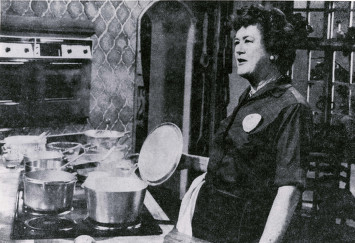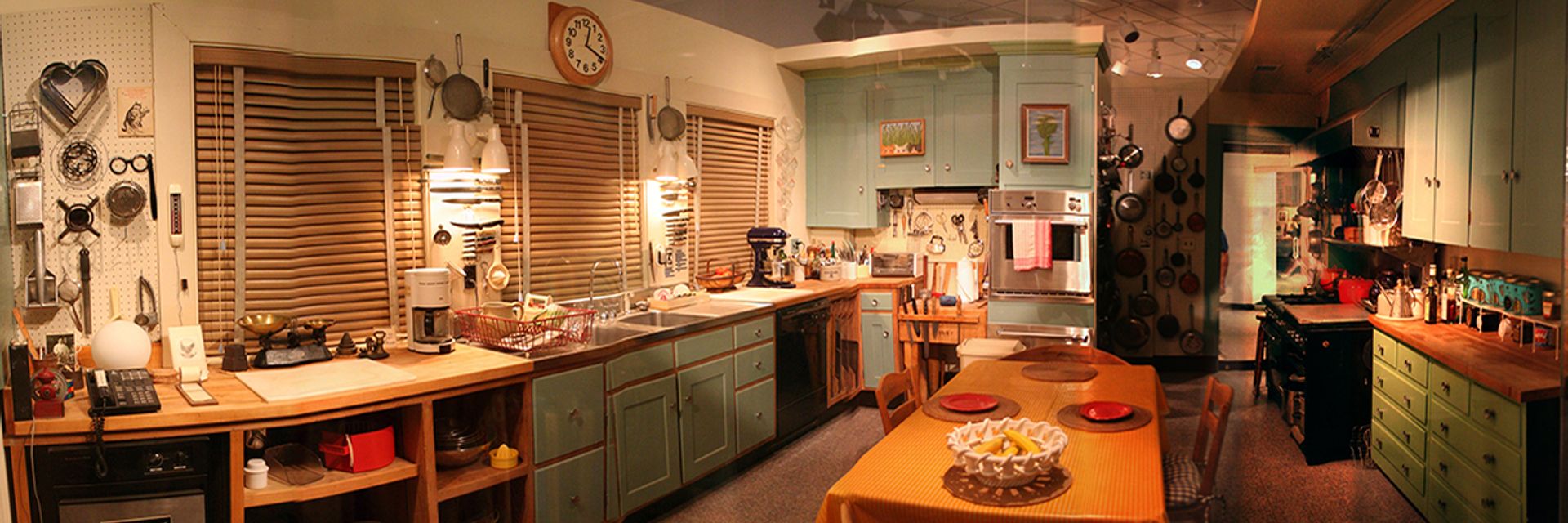Hailing from Pasadena, California, Julia Child’s passionate interest in the food of foreign lands led to her groundbreaking 1961 cookbook, Mastering the Art of French Cooking. Promoting the book on a Boston TV station quickly led to her own show, television stardom, and wide recognition by just her first name. Her sense of fun and warm personality inspired millions to take up cooking for pleasure and ignited a revolution in the way Americans eat, from fine restaurants to humble diners.
◊
In November 1948, an American couple, newly arrived in France, had lunch in Rouen. Their repast that day – a green salad, oysters, sole meuniere, bread, cheese, and dry white wine – might be the most consequential meal since the Last Supper. The two were Paul and Julia Child, on their way to Paris for Paul’s job with the State Department, and the food was Julia’s first taste of French cooking.
It was, you might say, love at first bite. Two decades later, her passion for good food would initiate a revolution, not only in how Americans eat – in ways well beyond the borders of French cuisine – but in the look and products of supermarkets, even the design of kitchens.
Should you doubt the last point, in 2001 the Smithsonian Institution was delighted to accept Julia’s donation of the entire kitchen from her Cambridge, Massachusetts, home – her tables, counters, pans, and utensils – where several seasons of her TV cooking shows were made. Now, housed with the Wright brothers’ airplane, John Glenn’s space capsule, Fort McHenry’s Star Spangled Banner, and Lincoln’s stovepipe hat, you can see Julia’s kitchen, ground zero for a social revolution that remains ongoing.
Another measure of Julia’s iconic status is that she is played by legendary actress Meryl Streep in the feature film adaptation of her cooking life, Julie & Julia.
She was not the likeliest person to introduce French cuisine to American homes. Born in 1912, Julia McWilliams grew up in Pasadena, California. Reaching 6’2” tall, she was an outdoorsy, athletic young woman. In one sign of her life to come, she had a vigorous appetite (though the food at home was basic meat-and-potatoes fare, along with the occasional Welsh rarebit). She was an indifferent student, however, and got poor marks in high school French.
French cuisine didn't end with Julia Child. Watch Planet Chef now, only on MagellanTV!
The Far East Romance of Julia and Paul Child
After graduating from Smith College, Julia got a job writing ad copy for a New York City furniture store. Back in California after a few years, she worked on the staff of a fashion magazine. At the outbreak of World War II, she moved to Washington, DC, to volunteer for war work. Deemed too tall for the Women’s Army Corps, Julia joined the Office of Strategic Services (OSS), the wartime predecessor of the Central Intelligence Agency.
Julia was sent to the island of Ceylon (today’s Sri Lanka) where she worked on a project to develop a shark repellent, and routed classified documents. There she met a fellow OSS operative, Paul Child, an artist and teacher who had spent the decade before the war working in Paris.
.jpg)
Mirepoix — carrots, onions, and celery — is a staple of French cuisine. (Credit: Glane23, via Wikimedia Commons)
Julia and Paul were part of a staff transfer to Kunming, China, where the two fell in love over a succession of dinners at local restaurants. “That is where I became interested in food,” Julia later recalled. “I just loved Chinese food.”
Back in the States, they married after the war. Paul joined the State Department, and the two were sent to Paris for five years, before being transferred to Marseille. Captivated by Paris’s markets, Julia began cooking at home and studying the language, eventually becoming fluent and enrolling in the professional program at Le Cordon Bleu cooking school.
“If you’re afraid of butter, use cream.” —Julia Child
It was during this food-intensive phase that she met Simone Beck, a woman working on a French cookbook for the American market. After graduating from Le Cordon Bleu in 1951, Julia, Beck, and Louisette Bertholle (Beck’s cookbook co-author) started a small school of their own, using Julia’s kitchen to teach cooking to expatriate American women.
Mastering the Art of French Cooking Finds an American Home
The two Frenchwomen asked Julia to evaluate their book project, which was having trouble finding a publisher. She advised adapting the recipes to use ingredients and utensils broadly available in the United States. With her incorporated changes, a U.S. publisher tentatively accepted the work-in-progress.
As Beck and Bertholle developed the book, the Childs left Paris for the south of France, then a stint in Germany. The first volume of the cookbook, 800 pages and still only a partial survey of the subject, was completed around the time Julia and Paul returned to Washington. But the publisher, unhappy with its length, and that further volumes were needed, finally turned it down.
During Paul’s next post, a two-year stint in Norway, Julia undertook a complete revision of Beck and Bertholle’s work. She simplified recipes and worked through a full repertory of dishes and sauces from appetizers to desserts, preparing each item for Paul at least six times. The finished volume was a comprehensive 750-page guide to French cuisine.
“I think every woman should have a blowtorch.” —Julia Child on the critical utensil to make crème brûlée.
In 1959, Julia’s work reached one more publishing company, and the desk of star editor Judith Jones. Two years earlier, Jones had discovered an obscure French edition of Anne Frank’s The Diary of a Young Girl, and guided its translation into English and publication in the United States. A dedicated Francophile, she tried Julia’s recipes at home and immediately grasped the book’s utility and importance. “Here was the cookbook I had been dreaming of,” she recalled. “One that took you by the hand and explained the whys and wherefores of every step of the recipe.”
Julia Becomes a TV Star
Mastering the Art of French Cooking was published in 1961, becoming a steady, though not spectacular, seller. A second edition appeared in 1970, and several revisions and many printings later, over a million copies are now in print.
But if the Child/Beck/Bertholle book wasn’t an immediate bestseller, it launched Julia into the still-new medium of television. There, her clear instructions, ready wit, big voice, and warm personality introduced the idea of cooking for the enormous pleasure of doing so to millions watching at home.
“This is my invariable advice to people: Learn how to cook – try new recipes, learn from your mistakes, be fearless and above all have fun.” —Julia Child
When the book was published, Paul and Julia were back in the States, living in Cambridge, Massachusetts. While promoting French Cooking on a local Boston book review program, Julia prepared a dish for the camera. Her telegenic skills were apparent immediately, and she was offered her own local show. Called The French Chef, its early seasons were shot in a TV studio before eventual relocation to the Childs’ kitchen.

Julia on the set of her cooking show. (Source: Wikimedia Commons)
Videotaped for later broadcast, the program’s low budget did not allow any retakes. Episodes aired as they occurred – sometimes soufflés didn’t rise, and sauces burned. On one occasion, Julia tried pan-flipping a potato pancake and missed. Without batting an eye, she scraped the pancake off the counter and advised viewers to “just scoop it back in the pan. Remember you are alone in the kitchen and nobody can see you.” (Urban legend has Julia saying the same thing after dropping a roast turkey, or maybe a leg of lamb. Sorry, that never happened.)
The Boston show was quickly picked up by public television stations across the country. Though not the first cooking program, the popularity of Julia’s “Hey, give it a shot and have some fun” attitude, and the message that a kitchen failure was no big deal, birthed a TV genre that remains wildly popular. She also inspired generations of American chefs to produce dishes with fresh ingredients in new combinations drawn from the cuisines of the world.
“The measure of achievement is not winning awards. It’s doing something that you appreciate, something you believe is worthwhile.” —Julia Child
Julia’s increasing popularity, and book sales, also allowed Judith Jones the freedom to publish other influential foreign cookbooks, including works on Italian food by Marcella Hazan, and Madhur Jaffrey’s guides to the cuisine of India. As these books appeared, and more people found enjoyment in cooking, American kitchens became more sophisticated. Stainless steel and Formica countertops gave way to woodblock and marble surfaces as found in Julia’s workplace. What’s more, high-end kitchenware, special pots, pans, dishes, and finely crafted utensils for the home cook became an enormous commercial market of its own.
The Enduring Legacy of a Life Well-lived
Julia closed each show by sitting down to eat what she had just prepared, pouring herself a glass of wine, and wishing viewers “bon appétit.” In 1981, she helped found the American Institute of Wine & Food, in association with California vintners, to promote a culture of fine dining. It is probably not coincidental that the number of small American vineyards and local craft breweries has expanded exponentially in the decades since.
The French Chef ran for 10 years, and was followed by other shows (most now available on DVD) featuring Julia dispensing recipes, advice, and visiting other chefs’ kitchens to talk food. There were also more cookbooks.
For those of us who love lamb, and a nourishing stew, here’s Julia’s recipe for a delectable lamb stew.
In 1992, Paul Child, whose photographs illustrated all of Julia’s books, died. Julia soldiered on. She started the Julia Child Foundation in 1995, which presents awards and grants promoting the culinary arts to this day. In 2000, she received France’s highest award, the Légion d’honneur, for her promotion of French culture. The 2001 Smithsonian donation of her kitchen only emphasized her status as an American treasure.
Retiring to California that year, Julia died of kidney failure in 2004, two days shy of her 92nd birthday. Retrospectives of her life made clear that her work had not only enriched countless lives but also revitalized an entire profession and transformed whole businesses. Because of her, there’s a good chance that today even a small American town will have at least one restaurant, or diner, where the cooks prepare interesting and tasty dishes, even if just a reimagined meatloaf with green beans or roast chicken and potatoes. “Cooking well,” Julia told us, “doesn’t mean cooking fancy.”
Ω
Title Image: The installation of Julia’s kitchen at the Smithsonian. (Credit: RadioFan, via Wikipedia)

